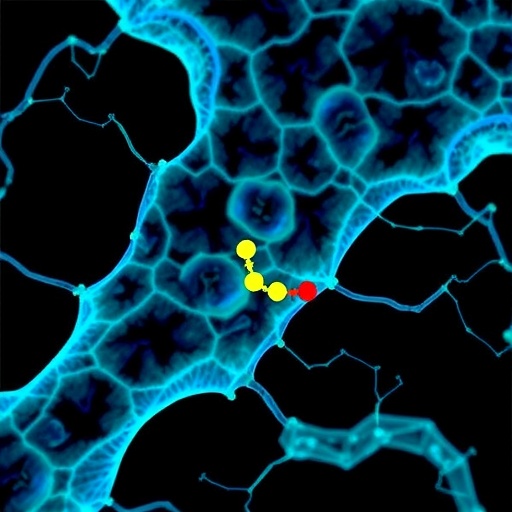In a groundbreaking study poised to revolutionize treatments for osteoporosis, researchers have unveiled an innovative approach that remodels the lipid metabolism of adipocytes within bone marrow, effectively reversing osteoporosis at a cellular and metabolic level. This pioneering work, recently published in Nature Communications, introduces a polycation-loaded enzyme-active framework designed to target and modulate fat cell functions in the bone microenvironment, offering new hope for millions suffering from bone degenerative diseases worldwide. The implications stretch far beyond traditional therapies, providing an advanced platform that leverages metabolic rewiring to combat bone loss more effectively and sustainably.
Osteoporosis, characterized by reduced bone density and structural deterioration, leads to increased fracture risk and significant morbidity, particularly among the aging population. Historically, treatments have focused primarily on inhibiting bone resorption or stimulating bone formation but have rarely addressed the fundamental interplay between bone cells and the lipid environment within the marrow. Increasing evidence suggests that adipocytes – fat storage cells residing in bone marrow – play a critical role in skeletal health by influencing both the local metabolic milieu and the balance between osteoblasts and osteoclasts, the cells responsible for bone formation and resorption, respectively. The novel framework developed by Lin, Gu, Zhang, and colleagues offers a paradigm shift by directly remodeling adipocyte lipid metabolism to restore homeostasis in osteoporotic bone marrow.
Central to the study is the development of a polycation-loaded enzyme-active framework, a sophisticated biomaterial engineered to interact dynamically with adipocytes. This framework integrates enzyme moieties capable of catalyzing specific lipid metabolic reactions, facilitating the breakdown and remodeling of lipid species within adipocytes. By harnessing the catalytic prowess of these enzyme components, the system selectively modulates fatty acid turnover and lipid composition, steering adipocytes away from a pathological lipid profile associated with bone degradation. This enzymatic framework is delivered via a polycation matrix, which not only stabilizes the enzymes but also enhances cellular uptake and interaction by exploiting electrostatic forces with negatively charged cell membranes.
The researchers meticulously characterized the biochemical and biophysical properties of the framework, demonstrating its stability, enzyme activity retention, and compatibility with the bone marrow microenvironment. In vitro experiments using cultured adipocytes derived from osteoporotic models revealed a marked shift in lipid metabolism upon treatment, characterized by enhanced lipolysis and altered fatty acid saturation profiles. These metabolic changes were linked with a reduction in pro-inflammatory signals and an improvement in the osteogenic potential of neighboring bone-forming cells. Importantly, the intervention did not induce cytotoxicity, highlighting its potential safety and efficacy for in vivo applications.
Animal models of osteoporosis provided further compelling evidence of the framework’s therapeutic capability. By administering the polycation-loaded enzyme-active framework directly into osteoporotic bone marrow, investigators observed a significant increase in bone mineral density and restoration of bone microarchitecture. Histological analyses confirmed a decrease in marrow adiposity alongside a resurgence of osteoblast activity, underscoring the restorative effect on bone remodeling dynamics. These findings not only validate the concept that targeting adipocyte metabolism can influence bone health but also establish this engineered framework as a viable candidate for clinical translation.
Delving deeper into the mechanistic underpinnings, the authors elucidated how modulating adipocyte lipid metabolism impacts the signaling pathways critical for bone homeostasis. The metabolic reprogramming induced by the framework diminished the secretion of adipokines and inflammatory factors known to impair osteoblast differentiation and function. Concurrently, the modified lipid environment favored the generation of lipid mediators conducive to osteogenic signaling, rebalancing the reciprocal crosstalk between adipocytes and bone cells. Such metabolic and paracrine adjustments cultivated a microenvironment supportive of bone regeneration rather than degeneration.
One of the study’s remarkable achievements is the integration of material science and metabolic biology, harnessing the functional versatility of enzyme-active biomaterials as a new frontier in metabolic disease treatment. The polycation matrix serves a dual purpose: enhancing enzyme delivery and modulating cellular interactions, which collectively amplify the therapeutic impact. This multidisciplinary approach exemplifies the trend toward precision bioengineering, where intricate cellular metabolism is manipulated through intelligently designed biomaterials to yield specific physiological outcomes. The implications extend to other diseases driven by metabolic dysregulation within complex tissue niches.
Clinicians and researchers alike are enthusiastic about the potential clinical applications of this technology. Current osteoporosis drugs often carry risks such as osteonecrosis or atypical fractures and focus narrowly on bone cell targets, neglecting the broader metabolic context. By contrast, reshaping the adipocyte metabolism addresses a previously underexplored axis in bone health, potentially offering durable therapeutic benefits with reduced side effects. Moreover, localized delivery via the polycation-enzyme framework may minimize systemic exposure, further enhancing safety profiles and patient compliance.
The authors acknowledge the transformative potential yet remain cautious, emphasizing the need for extensive clinical trials to evaluate long-term efficacy and safety in human populations. They also point to future research directions aimed at optimizing the enzyme composition within the framework, tailoring treatments to patient-specific metabolic signatures, and exploring combinatory therapies with established bone anabolic agents. Such personalized strategies might unleash even greater therapeutic synergies, solidifying metabolic remodeling as a cornerstone of osteoporosis management.
Additionally, this cutting-edge study stimulates curiosity about the broader role of marrow adipocytes as active regulators—not mere bystanders—in skeletal pathology. Their plasticity and dynamic metabolic functions emerge as critical determinants of bone integrity, offering novel intervention points beyond classical bone biology. This work inspires a reevaluation of adipose tissue’s contributions to skeletal diseases and encourages the development of parallel strategies tackling other marrow-related disorders through metabolic engineering.
Technically, the success of the polycation-loaded enzyme-active framework depends on precise control over enzyme kinetics and stability within the hostile marrow milieu. The researchers employed advanced polymer chemistry to calibrate charge densities and matrix architecture, ensuring sustained enzymatic activity without degradation or immune clearance. This fine-tuning represents a milestone in biomaterial design tailored for complex internal environments, likely to inspire analogous platforms targeting diverse metabolic diseases and tissue niches.
Beyond osteoporosis, the implications of this research resonate with growing interest in metabolic therapies that reshape cellular environments at the molecular level. By proving that adipocyte lipid metabolism can be remodeled to affect tissue regeneration, this approach opens new investigative avenues into metabolic dysfunction diseases such as obesity-induced skeletal fragility, bone marrow fibrosis, and even hematopoietic disorders. The marriage of metabolic biochemistry with materials science is laying the foundation for a new class of biomaterials with tunable bioactivities anchored in enzyme catalysis.
As this innovative technology evolves, ethical and regulatory considerations come to the fore, particularly regarding the deployment of enzyme-active materials in human subjects. The safety protocols, scaling of production, and long-term biodistribution profiles require rigorous examination to ensure patient well-being. However, given the unmet needs in osteoporosis therapy and the pressing public health challenge posed by aging populations, the momentum behind such transformative, metabolism-targeted interventions continues to grow.
Ultimately, the work by Lin and colleagues marks a significant leap toward mastering the metabolic crosstalk between adipocytes and bone cells through engineered biomaterials. This approach casts light on the intimate biochemical dialogue governing skeletal health and disease, harnessing it for therapeutic gain. As the field advances, clinicians may well witness a future where bone fragility is not merely treated symptomatically but reversed fundamentally by reprogramming the metabolic fabric of the bone marrow niche.
This study exemplifies how cross-disciplinary innovation in metabolic engineering, biomaterials science, and bone biology can converge to yield therapies that are both mechanistically insightful and clinically impactful. It challenges existing dogmas and beckons a new era wherein the metabolism of adipocytes is not an obstacle but a therapeutic target in itself. The journey from bench to bedside may be complex, yet the promise of restoring bone health by remodeling adipocyte lipid metabolism is now an exciting and tangible reality.
Subject of Research: Remodeling adipocyte lipid metabolism to reverse osteoporotic bone marrow
Article Title: Remodeling adipocytes’ lipid metabolism with a polycation loaded enzyme-active framework reverses osteoporotic bone marrow
Article References:
Lin, W., Gu, S., Zhang, X. et al. Remodeling adipocytes’ lipid metabolism with a polycation loaded enzyme-active framework reverses osteoporotic bone marrow. Nat Commun 16, 8009 (2025). https://doi.org/10.1038/s41467-025-63376-4
Image Credits: AI Generated
Tags: adipocyte function in bone healthadvanced therapies for bone diseasesaging population bone healthbone density and structural deteriorationcellular approach to osteoporosislipid metabolism in bone marrowmetabolic rewiring for bone lossNature Communications research on osteoporosisosteoblasts and osteoclasts balanceosteoporosis treatment innovationspolycation enzyme frameworkreversing osteoporosis at a cellular level





